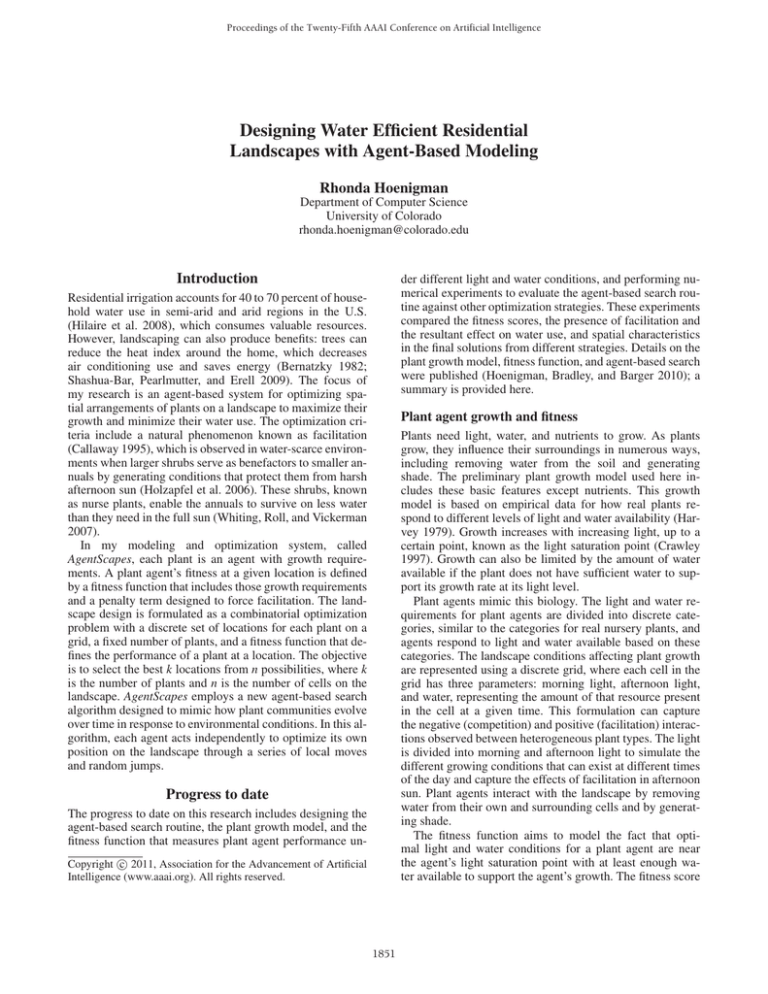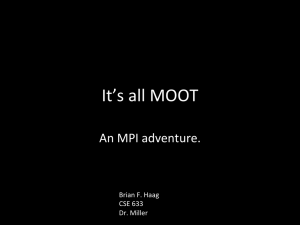
Proceedings of the Twenty-Fifth AAAI Conference on Artificial Intelligence
Designing Water Efficient Residential
Landscapes with Agent-Based Modeling
Rhonda Hoenigman
Department of Computer Science
University of Colorado
rhonda.hoenigman@colorado.edu
Introduction
der different light and water conditions, and performing numerical experiments to evaluate the agent-based search routine against other optimization strategies. These experiments
compared the fitness scores, the presence of facilitation and
the resultant effect on water use, and spatial characteristics
in the final solutions from different strategies. Details on the
plant growth model, fitness function, and agent-based search
were published (Hoenigman, Bradley, and Barger 2010); a
summary is provided here.
Residential irrigation accounts for 40 to 70 percent of household water use in semi-arid and arid regions in the U.S.
(Hilaire et al. 2008), which consumes valuable resources.
However, landscaping can also produce benefits: trees can
reduce the heat index around the home, which decreases
air conditioning use and saves energy (Bernatzky 1982;
Shashua-Bar, Pearlmutter, and Erell 2009). The focus of
my research is an agent-based system for optimizing spatial arrangements of plants on a landscape to maximize their
growth and minimize their water use. The optimization criteria include a natural phenomenon known as facilitation
(Callaway 1995), which is observed in water-scarce environments when larger shrubs serve as benefactors to smaller annuals by generating conditions that protect them from harsh
afternoon sun (Holzapfel et al. 2006). These shrubs, known
as nurse plants, enable the annuals to survive on less water
than they need in the full sun (Whiting, Roll, and Vickerman
2007).
In my modeling and optimization system, called
AgentScapes, each plant is an agent with growth requirements. A plant agent’s fitness at a given location is defined
by a fitness function that includes those growth requirements
and a penalty term designed to force facilitation. The landscape design is formulated as a combinatorial optimization
problem with a discrete set of locations for each plant on a
grid, a fixed number of plants, and a fitness function that defines the performance of a plant at a location. The objective
is to select the best k locations from n possibilities, where k
is the number of plants and n is the number of cells on the
landscape. AgentScapes employs a new agent-based search
algorithm designed to mimic how plant communities evolve
over time in response to environmental conditions. In this algorithm, each agent acts independently to optimize its own
position on the landscape through a series of local moves
and random jumps.
Plant agent growth and fitness
Plants need light, water, and nutrients to grow. As plants
grow, they influence their surroundings in numerous ways,
including removing water from the soil and generating
shade. The preliminary plant growth model used here includes these basic features except nutrients. This growth
model is based on empirical data for how real plants respond to different levels of light and water availability (Harvey 1979). Growth increases with increasing light, up to a
certain point, known as the light saturation point (Crawley
1997). Growth can also be limited by the amount of water
available if the plant does not have sufficient water to support its growth rate at its light level.
Plant agents mimic this biology. The light and water requirements for plant agents are divided into discrete categories, similar to the categories for real nursery plants, and
agents respond to light and water available based on these
categories. The landscape conditions affecting plant growth
are represented using a discrete grid, where each cell in the
grid has three parameters: morning light, afternoon light,
and water, representing the amount of that resource present
in the cell at a given time. This formulation can capture
the negative (competition) and positive (facilitation) interactions observed between heterogeneous plant types. The light
is divided into morning and afternoon light to simulate the
different growing conditions that can exist at different times
of the day and capture the effects of facilitation in afternoon
sun. Plant agents interact with the landscape by removing
water from their own and surrounding cells and by generating shade.
The fitness function aims to model the fact that optimal light and water conditions for a plant agent are near
the agent’s light saturation point with at least enough water available to support the agent’s growth. The fitness score
Progress to date
The progress to date on this research includes designing the
agent-based search routine, the plant growth model, and the
fitness function that measures plant agent performance unc 2011, Association for the Advancement of Artificial
Copyright Intelligence (www.aaai.org). All rights reserved.
1851
Research plan
includes a biological portion based on the plant agent’s biological properties and an engineering portion–a penalty for
high-water-use conditions. The plant growth model and the
landscape conditions determine the biological portion of the
score. The penalty is a function of the landscape light, the
agent’s light saturation point, and the agent’s size. The final fitness score is based on simulating growth for multiple
days to capture how the landscape changes over time. For
each simulated day, the morning fitness score is calculated
from the light and water available and the agent’s light and
water requirements. Next, the landscape is updated by removing the water from the landscape that the agent used in
the morning. This process is repeated to calculate afternoon
fitness, and, again, update the landscape. The agent’s daily
fitness score is the sum of its morning and afternoon fitness
scores. The penalty value for light conditions beyond the
plant agent’s light saturation point is then subtracted from
this daily fitness score. The fitness calculation is repeated
for a pre-determined number of days to get the final fitness
score for a plant at a particular location. The fitness score
for an arrangement of plant agents is the sum of the fitness
scores for each individual agent.
The results in this research to date show that this agentbased model successfully forces facilitation, produces fitness scores competitive with other search algorithms, and
generates spatial patterns that are characteristically different
from those produced through another optimization strategy.
The work remaining on this thesis can be summarized as
follows:
• Evaluate model parameters—There are several model
parameters that affect resource use and interactions on the
landscape. These will be evaluated to determine how resource constraints generate facilitation or competition for
different plant populations.
• Fitness function modifications—The fitness function is
engineered to force facilitation. Other modifications to
this function will be explored to engineer other agent behaviors that could also generate water savings. One example is clustering plants by their water requirements to
reduce the variability of water requirements within a local
area.
• Evaluate other optimization strategies—Other optimization strategies, such as genetic algorithms or scatter search, could produce different spatial patterns and
will provide additional comparisons for the agent-based
search.
Numerical experiments
Numerical experiments compared fitness scores, the presence of facilitation and water use, and spatial characteristics on simulated landscapes using different optimization
strategies, including the agent-based search algorithm. The
other strategies represented a range of approaches. A random algorithm—place plants randomly on the landscape—
was effectively no optimization. Greedy search reflects how
a gardener might design a landscape—select the best place
for the plant without complete knowledge of the interactions
between plants or the benefits of facilitation. Simulated annealing (SA) is a commonly used meta-heuristic with global
control over the fitness function. The agent-based search is
a distributed approach where each agent has a fixed number
of times it can move and a local search radius. The agent
searches locally and with random jumps to optimize its own
location without central control.
On a series of small problems, the agent-based search algorithm produced higher fitness scores than random placements and greedy search and was competitive with SA. The
agent-based search and SA were used on a series of larger
problems to evaluate the presence of facilitation and the spatial characteristics of the landscapes. Both algorithms generated solutions where facilitation was common. Water use in
these solutions was lower than water use in random solutions where facilitation was not common by as much as 40
percent for high-water plants. There were also notable differences in the spatial characteristics in the solutions from
the agent-based search and SA algorithms. They produced
different clustering patterns for the plants in ways that affected the light and water distribution on the landscape. The
differences in these patterns demonstrate the value of different optimization strategies for this problem, as well as the
flexibility of the agent-based model.
References
Bernatzky, A. 1982. The contribution of trees and green
spaces to a town climate. Energy Build. 5:1–10.
Callaway, R. 1995. Positive interactions among plants. The
Botanical Review 61:306–349.
Crawley, M., ed. 1997. Plant Ecology. Oxford: Blackwell
Scientific Publications.
Harvey, G. 1979. Photosynthetic performance of isolated
leaf cells from sun and shade plants. Carnegie Inst. Washington Yearbook 79:161–164.
Hilaire, R. S.; Arnold, M.; Wilkerson, D.; Devitt, D.; Hurd,
B.; Lesikar, B.; Lohr, V.; Martin, C.; Mcdonald, G.; Morris,
R.; Pittenger, D.; Shaw, D.; and Zoldoske, D. 2008. Efficient water use in residential urban landscapes. HortScience
43(7):2081–2092.
Hoenigman, R.; Bradley, E.; and Barger, N.
2010.
Agentscapes–Designing water efficient landscapes using
distributed agent-based optimization. Proceedings of the
12th Annual Conference Companion on Genetic and Evolutionary Computation Conference: Late Breaking Papers.
Holzapfel, C.; Tielborger, K.; Parag, H.; Kigel, J.; and Sternberg, M. 2006. Annual plant-shrub interactions along an
aridity gradient. Basic and Applied Ecology 7:268–279.
Shashua-Bar, L.; Pearlmutter, D.; and Erell, E. 2009. The
cooling efficiency of urban landscape strategies in a hot dry
climate. Landscape and Urban Planning 92:179–186.
Whiting, D.; Roll, M.; and Vickerman, L. 2007. Plant
Growth Factors: Light – Garden Notes 142. Colorado State
University Cooperative Extension.
1852





